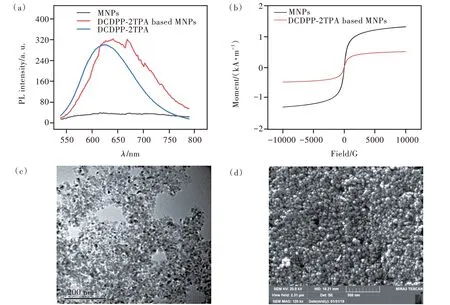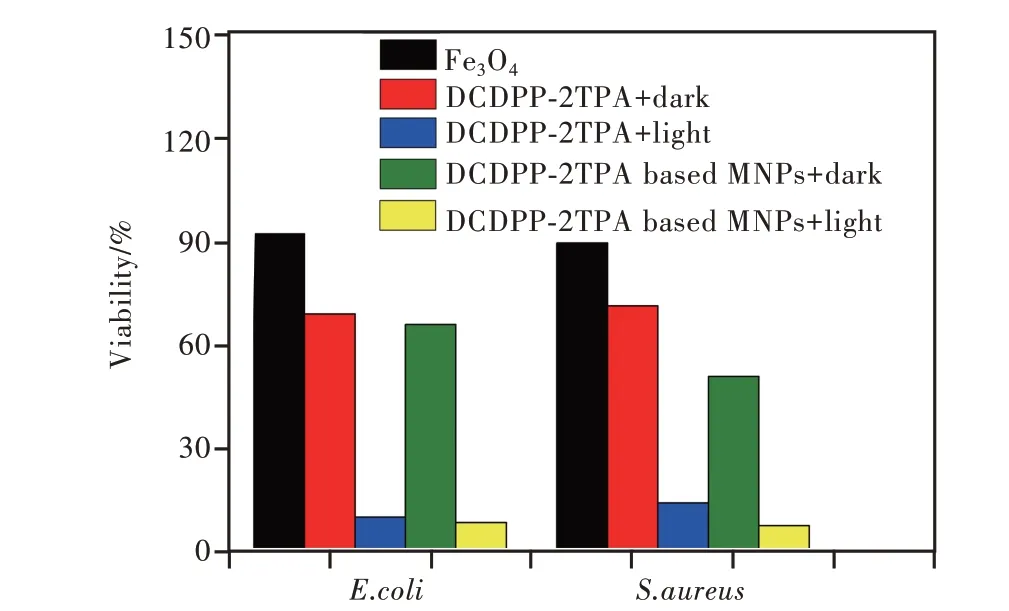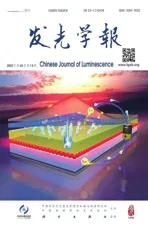Utilizing NIR AIE Luminogen Based Magnetic Nanoparticle for Light-enhanced Bacterial Killing
2022-11-07XIEHongqinXIEYangziWANGYuetingJIAOZheGUOZongningHUANGXuelinCHENMingLUOXiaozheng
XIE Hong-qin,XIE Yang-zi,WANG Yue-ting,JIAO Zhe*,GUO Zong-ning,HUANG Xue-lin*,CHEN Ming,LUO Xiao-zheng
(1.Guangdong Dongguan Ecological and Environmental Monitoring Station,Dongguan 523106,China;2.Dongguan University of Technology,Dongguan 523808,China;3.Huangpu Customs District Technology Center,Dongguan 523000,China;4.College of Chemistry and Materials Science,Jinan University,Guangzhou 510632,China)
*Corresponding Authors,E-mail:jiaoz@dgut.edu.cn;34056583@qq.com
Abstract:NIR photosensitizers(PSs)could significantly improve the efficacy of photodynamic therapy due to the long-wavelength favorability for deeper tissue penetration and lower biological damage.In this paper,a deep-red emissive AIEgens 5,6-bis(4′-(diphenylamino)-[1,1′-biphenyl]-4-yl)pyrazine-2,3-dicarbonitrile(DCDPP-2TPA)was synthesized for light-enhanced bacterial killing.Due to the advantage of AIEgens which are ultra-emissive in the aggregate states or solid states,DCDPP-2TPA was incorporated into magnetic nanoparticle to increase aggregation enhanced reactive oxygen species(ROS)generation property as well as magnetic separation convenience.The magnetic particles were studied by scanning electron microscope(SEM),transmission electron microscope(TEM),X-ray diffraction(XRD),and fluorescence spectrophotometer,etc.The capacity of bacterial killing was exhibited on E.coli and S.aureus under light irradiation.Due to the aggregation enhanced ROS generation,the viability of E.coli and S.aureus treated with DCDPP-2TPA based magnetic nanoparticle with room light illumination for 30 min are 7.5% and 9.0%,which was superior to DCDPP-2TPA(10% and 14% respectively).The significant superiority of magnetic nanoparticles is that it can be withdrawn easily and continuously used for bacteria killing by applying light to induce ROS generation.
Key words:AIE luminogen;magnetic nanoparticle;bacterial killing
1 Introduction
Outbreaks of waterborne pathogens(such as Escherichia coli(E.coli),Staphylococcus spp.and Salmonella spp.)regularly occur especially during epidemic situation,war fare or natural disasters.Due to the very low infection dose(around 100 organisms)and given the biological diversity of harmful pathogens,it is a continual challenge to prevent infectious disease outbreaks.Antibiotics are the most widely used materials for pathogen prevention and infection treatment,but are becoming less efficient due to the emergence of antibiotic-resistant bacterial strains[1].Recently,nanomaterials such as TiO2,Ag2O,have been an alternative,but its second pollution has been found[2].Therefore,it is crucial to develop reusable,safe and convenient material,especially applied in the emergent occasion.
Photodynamic therapy(PDT)is a potential alternative to antibiotics to kill bacteria[3-5].In general,PDT employs photosensitizers to absorb light and generate single excited state(S1),then the S1 state can further transfer the energy to triplet excited state(T1),which would sensitize the ambient triplet oxygen,resulting in formation of the destructive singlet oxygen or other reactive oxygen species(ROS)[6-7].PDT can target both external and internal structures of bacteria,and not really requires the photosensitizers to enter bacteria,thus,the sterilization mechanism of PDT is different from traditional antibiotics[8].Therefore,bacteria can hardly develop resistance to PDT[9].The conventional photosensitizers suffered from the notorious aggregation-caused quenching(ACQ)effect after they accumulated,which will lead to the reduction in their fluorescence intensities in the solid state,thus seriously eroding the performance.The concept of AIE(aggregationinduced emission)was coined by Tang's group in 2001[10-11].The aggregation-induced emission fluorogens(AIEgens)are non-emissive in dilute solution but emit intensely upon aggregate formation,which are very suitable for solid-state application.The unique properties of AIEgens make them excellent candidates for fluorescent nanoparticle development[12].
Development of AIEgens to exhibit ROS generation ability and applications in PDT has been reported recently[13-16].NIR AIEgens could be excited by simultaneously absorbing long-wavelength photons.This unique character is advantageous for PDT,due to its deeper penetration power,lower cell radiation and less background fluorescence leading to better signal to noise ratio.However,there are only a few reports of such materials for three-photon PDT applications,due to low optical stability and complex synthesis.As reported in our previous literature,a deepred emissive AIEgen 5,6-bis(4′-(diphenylamino)-[1,1′-biphenyl]-4-yl)pyrazine-2,3dicarbonitrile(DCDPP-2TPA)was synthesized,which exhibited bright three-photon fluorescence signals with deepred emission molecules and high photostability due to absence of nonaromatic double bonds in DCDPP-2TPA molecules[17].It was applied for through-skull fluorescence microscopic imaging of mouse cerebral vasculature without craniotomy and skull-thinning.However,its potentiality for bacterial killing has never been explored.
Through encapsulating AIEgens within a certain matrix to form nanoparticles(NPs),the intramolecular motions of AIE molecules can be suppressed,and the fluorescence quantum yield,especially aggregation enhanced property is greatly improved.The condensed particles can also largely reduce the photo-oxidation of dye molecules by keeping the oxygen out.Among different NPs,magnetic NPs(MNPs)show great advantage for quick separation once completed.Therefore,it is expected that by incorporating ROS generation AIEgens with magnetic NPs,novel multifunctional bacteria-killing materials will be developed for portable on-site application.
Herein,based on the NIR AIEgens(DCDPP-2TPA)that has been reported by our group,we further developed multifunctional MNPs as PDT agents for bacterial killing.The structure of the MNPs was studied.The ROS generation property of DCDPP-2TPA was examined by SOSG.Finally,it was applied for Gram-negative bacteriaE.coliand Grampositive bacteriaS.aureuskilling in water.
2 Experiment
2.1 Chemicals and Regents
Sodium hydroxide,ferrous chloride,ferric chloride,2,3-diaminomaleonitrile and dimethyl sulfoxide(DMSO)were purchased from Tianjin Damao Chemical Reagent Company.Ethyl acetate,methanol,tetrahydrofuran,sodium dodecyl benzene sulfonate(SDBS)and sodium chloride were obtained from Tianjin Fuchen Chemical Reagent Company.Agar powder,tryptone and beef extract were bought from Beijing Baolai Tech Co.,Limited.Singlet oxygen sensor green(SOSG)was bought from Shanghai Maokang Biotech Co.,Limited.1,2-bis(4'-(diphenylamino)-[1,1'-biphenyl]-4-yl)ethane-1,2-dione(1)was obtained in our previous work[17].
2.2 Synthesis of 5,6-Bis(4′(-diphenylamino)-[1,1′-biphenyl]-4-yl)pyrazine-2,3-dicarbonitrile(DCDPP-2TPA,2)
The synthetic route DCDPP-2TPA(2)was provided in the supporting information(Fig.S1).1,2-bis(4'-(diphenylamino)-[1,1'-biphenyl]-4-yl)ethane-1,2-dione(1,500 mg,0.72 mmol),2,3-diaminomaleonitrile(2,85 mg,0.79 mmol)and 30 mL of acetic acid were added into a 100 mL round-bottom flask.The mixture was stirred at reflux for 12 h.Afterwards,the mixture was cooled down to the room temperature and poured into the ice water.Then,the dichloromethane was added and the red organic phase was collected followed by washing with water three times.The organic phase was concentrated by reduce pressure and the product was purified by a silica gel column using dichloromethane/petroleum ether(v/v=1∶2)as eluent.A red powder of DCDPP-TPA was obtained in a yield of 72.3%.1H NMR(300 MHz,CD2Cl2):7.73-7.64(m,8H),7.58-7.55(d,4H),7.35-7.30(t,8H),7.16-7.08(m,16H).13C NMR(75 MHz,CDCl3):154.8,148.2,147.4,143.4,133.5,132.6,130.4,129.4,127.8,126.8,124.8,123.4,123.3,113.3.HRMS(MALDI-TOF):m/z768.299 9[M+,calcd for 768.300 1](Fig.S2,S3,S4).
2.3 Preparation of DCDPP-2TPA Based MNPs
Sodium hydroxide was first prepared in aqueous solution(0.605 mol/L).Then ferrous chloride and ferric chloride were mixed and dissolved(concentrations were 0.05 mol/L and 0.10 mol/L respectively)and equipped in the microwave-ultrasonic system.After reaction for 1 h at 40℃,the sodium hydroxide solution was added drop by drop in N2atmosphere.Finally,the resultant product Fe3O4MNPs was washed by water for three times and dried overnight for use.For preparation of DCDPP-2TPA based MNPs,SDBS was prepared in aqueous solution(1.2 mmol/L),then 1 mg of DCDPP-2TPA was added and sonicated for 5 min.After that,1 mL of DMSO was added and sonicated for 10 min.Finally,Fe3O4MNPs(0.018 g)was added and stirred for 2 h.The resultant product DCDPP-2TPA based MNPs was washed and dried in vacuum oven for use.
2.4 Application of DCDPP-2TPA Based MNPs for Bacteria Killing
The prepared medium was poured evenly into six Petri dishes for cooling and solidification.The bacterial(the absorption ODs at 600 nm was 0.5)culture medium was diluted 1 000 times with PBS buffer.1 mL of each were added to six disposable centrifuge tubes,and following adding of Fe3O4MNP,DCDPP-2TPA and DCDPP-2TPA based MNPs respectively(The mass was all 1.0 mg).Six centrifuge tubes were incubated in the incubator at 37℃for 30 min,and then the light group was exposed to natural light for 30 min.Finally,six centrifuge tubes were centrifuged,100 μL supernatant from each centrifuge tube was added to the prepared solid medium,and cultured at 37℃for 24 h.All solutions and materials are autoclaved before use.

Fig.1(a)PL spectra of DCDPP-2TPA,MNPs and DCDPP-2TPA based MNPs.(b)Magnetizing curve of MNPs and DCDPP-2TPA based MNPs.(c)TEM image of DCDPP-2TPA based MNPs.(d)SEM image of DCDPP-2TPA based MNPs.
The reuse of DCDPP-2TPA based MNPs bacteria killing was studied by magnetic recycling.First,10 mg of DCDPP-2TPA based MNPs is dispersed in 2 mL of aqueous solution to form a suspension,and then the solution is placed on the magnet for 1 min.After separation of the solution,the DCDPP-2TPA based MNPs was used for next cycle.
3 Results and Discussion
3.1 Characterization of Magnetic Particles
The appearance of the nanoparticles was shown in Fig.S5.It was black particles under nature light and red emissive under UV light,which showed that DCDPP-2TPA had been combined with Fe3O4MNP.The photoluminance spectra(PL)of DCDPP-2TPA,MNPs and DCDPP-2TPA based MNPs were provided in Fig.1(a).The fluorescence emission at 650 nm was both observed in DCDPP-2TPA,and DCDPP-2TPA based MNPs.Besides,the magnetic curve(Fig.1(b))showed the nanoparticles exhibited superparamagnetic property as Fe3O4.The micro-morphology of the nanoparticles was studied by transmission electron microscope(TEM)(Fig.1(c))and scanning electronic microscopy(SEM)(Fig.1(d)),the particle was sphere and well-distributed with diameter at about 30-40 nm.
X-ray diffraction spectrum and IR spectrum were also obtained(Fig.S6).The diffraction peaks at 30.22°,35.66°,43.25°,53.65° and 62.88° in X-ray diffraction spectrum proved the existence of Fe3O4.In the IR spectrum of DCDPP-2TPA based MNPs,574 cm-1and 1 614 cm-1are the Fe—O characteristic stretching vibration peaks of Fe3O4and MNP,but the peaks of DCDPP-2TPA were not observed clearly.It might be because of low mass ratio of DCDPP-2TPA in Fe3O4MNP.
The surface potential of MNPs and DCDPP-2TPA based MNPs were studied(Fig.S6).The results showed that the surface potential increased with the binding of DCDPP-2TPA with MNPs.Besides,the hydrodynamic diameters of MNPs and DCDPP-2TPA based MNPs were measured(Fig.S7).Compared with MNPs,the hydrodynamic particle size of DCDPP-2TPA based MNPs increased,which was caused by the combination of DCDPP-2TPA and MNPs.The coverage amount of DCDPP-2TPA on magnetic nanoparticles was also studied by the comparative absorption ODs at 510 nm(Fig.S9).It was measured with the reference DCDPP-2TPA solution(1.16×10-2mmol/L)before the insertion of the magnetic particles for reaction and the remaining DCDPP-2TPA solution obtained after the reaction with the particles.The ODs difference indicates that 0.037∶1(mass ratio)of DCDPP-2TPA is immobilized onto the surface of magnetic particles.
3.2 Evaluation of Aggregation Enhanced ROS Generation by SOSG
The mechanism for killing bacteria was based by the singlet-oxygen produced by the DCDPP-2TPA.To investigate the ability to generate1O2,the1O2quantum yield was determined using a chemical trapping method by monitoring the absorption of 9,10-anthracenediyl-bis(methylene)dimalonic acid at 378 nm,and the1O2quantum yield was 12%.SOSG was applied for detection of singlet-oxygen in this system.As seen in Fig.2,the PL spectra of SOSG was obtained in the presence of DCDPP-2TPA and DCDPP-2TPA based MNPs.In the mixture of SOSG and DCDPP-2TPA,the PL intensity at 530 nm both became stronger with the irradiation time.When the time reached 60 min,the emission became stable.While in the mixture of SOSG and DCDPP-2TPA based MNPs,the PL intensity at 530 nm increased along with prolonged time at 60 min.Due to the aggregation enhanced ROS generation,the PL intensity of SOSG was higher in the presence of MNPs than DCDPP-2TPA alone.The reason might be that the condensed packing of AIE molecules in the nanoaggregates blocks the intramolecular motions,promotes the radiative decay and enhances the emission,therefore AIE MNPs are with intense fluorescence and the emission can be retained after continuous irradiation.

Fig.2(a)The PL spectra of SOSG in the presence of DCDPP-2TPA.(b)The PL spectra of SOSG in the presence of DCDPP-2TPA based MNPs.(c)PL intensity change of SOSG in the presence/absence of DCDPP-2TPA.
3.3 Study of the Bacteria Killing by DCDPP-2TPA and DCDPP-2TPA Based MNPs
Gram-negative bacteriaE.coliand Gram-positive bacteriaS.aureuswere tested to study the killing capacity of DCDPP-2TPA and DCDPP-2TPA based MNPs.The images of plates for the quantification of the killing effect onE.coliandS.aureuswere obtained to gain a direct impression of the killing effect(Fig.3-4).Without treatment,the bacteria grow healthily on the plate.When treated with DCDPP-2TPA in the dark,the amount ofE.colidecreased to some extent,but there are still some alive bacteria on the plate(Fig.3(b)),suggesting the inefficient killing of DCDPP-2TPA without light irradiation.In the presence of both DCDPP-2TPA and light irradiation,E.coliwas killed effectively and almost no colony forms on the plate,which showed the high bacterial killing efficiency under light irradiation(Fig.3(e)).A similar effect is observed on theS.aureus(Fig.4).It proved that DCDPP-2TPA could kill both Gram-positive and-negative bacteria efficiently with light irradiation.

Fig.3 Plates of E.coli under different conditions.(a)Without treatment.(b)Treatment with DCDPP-2TPA in dark.(c)Treatment with DCDPP-2TPA based MNPs in dark.(d)Treatment with MNPs.(e)Treatment with DCDPP-2TPA in light.(f)Treatment with DCDPP-2TPA based MNPs in light.
The bacterial killing capacity of DCDPP-2TPA based MNPs was studied.Firstly,the effect of Fe3O4MNPs on bacteria viability was investigated in the absence of DCDPP-2TPA.As seen in Fig.3 and Fig.4,theE.coliandS.aureusboth remain healthy in the presence of Fe3O4MNPs,showing that the magnetic particle had little effect for killing bacteria.Treatment with DCDPP-2TPA based MNPs in the dark decreases the amount ofE.coli/S.aureusto some extent,but there are still some alive bacteria that can grow to form colonies on the plate,suggesting the inefficient killing in the dark.In the presence of both DCDPP-2TPA based MNPs and light irradiation,bothE.coliandS.aureusare killed effectively and their viability,which is a good sign of high bacterial killing efficiency under light irradiation.

Fig.4 Plates of S.aureus under different conditions.(a)Without treatment.(b)Treatment with DCDPP-2TPA in dark.(c)Treatment with DCDPP-2TPA based MNPs in dark.(d)Treatment with MNPs.(e)Treatment with DCDPP-2TPA in light.(f)Treatment with DCDPP-2TPA based MNPs in light.
The killing efficiency was further assessed by the plate-count method(Fig.5).The viability of bacteria remained unchanged in the presence of Fe3O4MNPs,When treated with DCDPP-2TPA and then stored in the dark for 30 min,the viabilityE.coliandS.aureusdecreased to 70% and 72% respectively,demonstrating the dark toxicity of DCDPP-2TPA towardE.coliandS.aureus.Light irradiation can significantly increase the killing efficiency on both Gram-positive and-negative bacteria.The viability ofE.coli andS.aureustreated with DCDPP-2TPA with room light illumination for 30 min is 10% and 14%(Fig.5).DCDPP-2TPA based MNPs exhibited superior bacterial killing capacity,the viability was decreased to 7.5%and 9.0%respectively.All these results prove that together with light irradiation,DCDPP-2TPA based MNPs could kill both Gram-positive and-negative bacteria efficiently.

Fig.5 Viability of E.coli and S.aureus cultured in different conditions
The stability of the DCDPP-2TPA based MNPs was tested by dynamic light scattering spectrometry.The hydrodynamic particle size showed that these nanoparticles were prone to aggregate into large particles with a particle size greater than 1 μm(Fig.S10).
The reuse of DCDPP-2TPA based MNPs bacteria killing was studied by magnetic recycling.As seen in Fig.S11,the DCDPP-2TPA based MNPs can be separated from the solution facially by magnet.After five cycles,the killing effect ofE.coliandS.aureuswas still obvious(Fig.S12).Note that five times is not the limit of repeatable cycles,DCDPP-2TPA based MNPs can be repeated sterilization without degrading performance.
4 Conclusion
In this paper,a magnetic antibacterial nanocomposite was facilely synthesized by incorporation of DCDPP-2TPA.The reactive oxygen species(ROS)generation property was found enhanced by AIE characteristics as well as magnetic separation convenience.The killing bacteria capacity was proved when it was applied for Gram-negative bacteriaE.coliand Gram-positive bacteriaS.aureus.In particular,since the nanoparticles can be facilely separated from the solvent mixture by magnetic field,it has high potential to be used in environmental industry fields such as water disinfection system.
Supplementary Information and Response Letter are available for this paper at:http://cjl.lightpublishing.cn/thesisDetails#10.37188/CJL.20220015.
